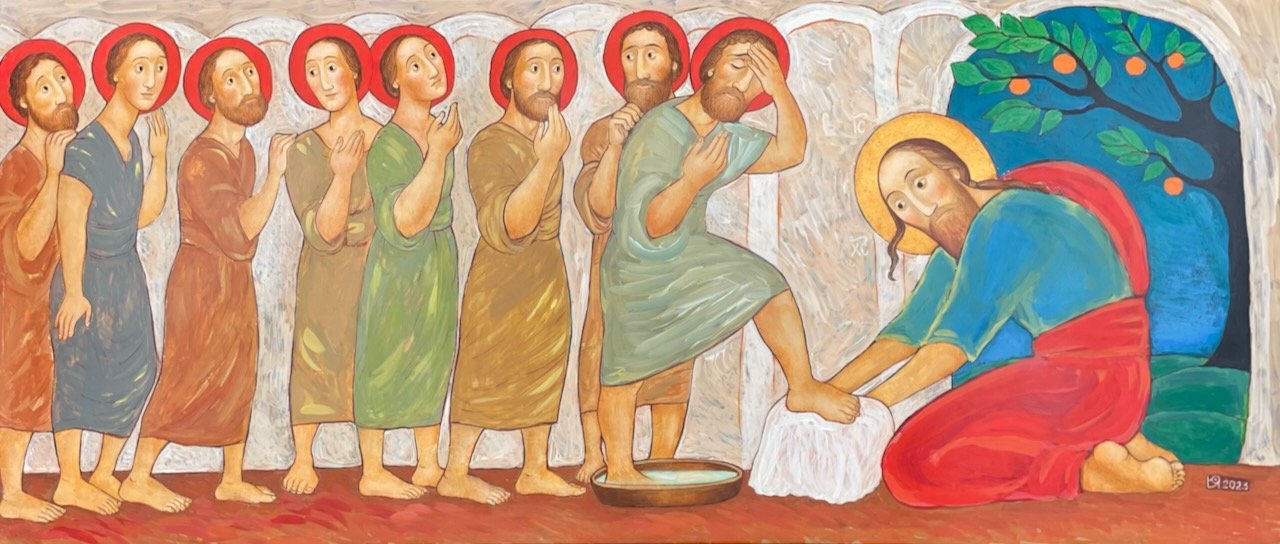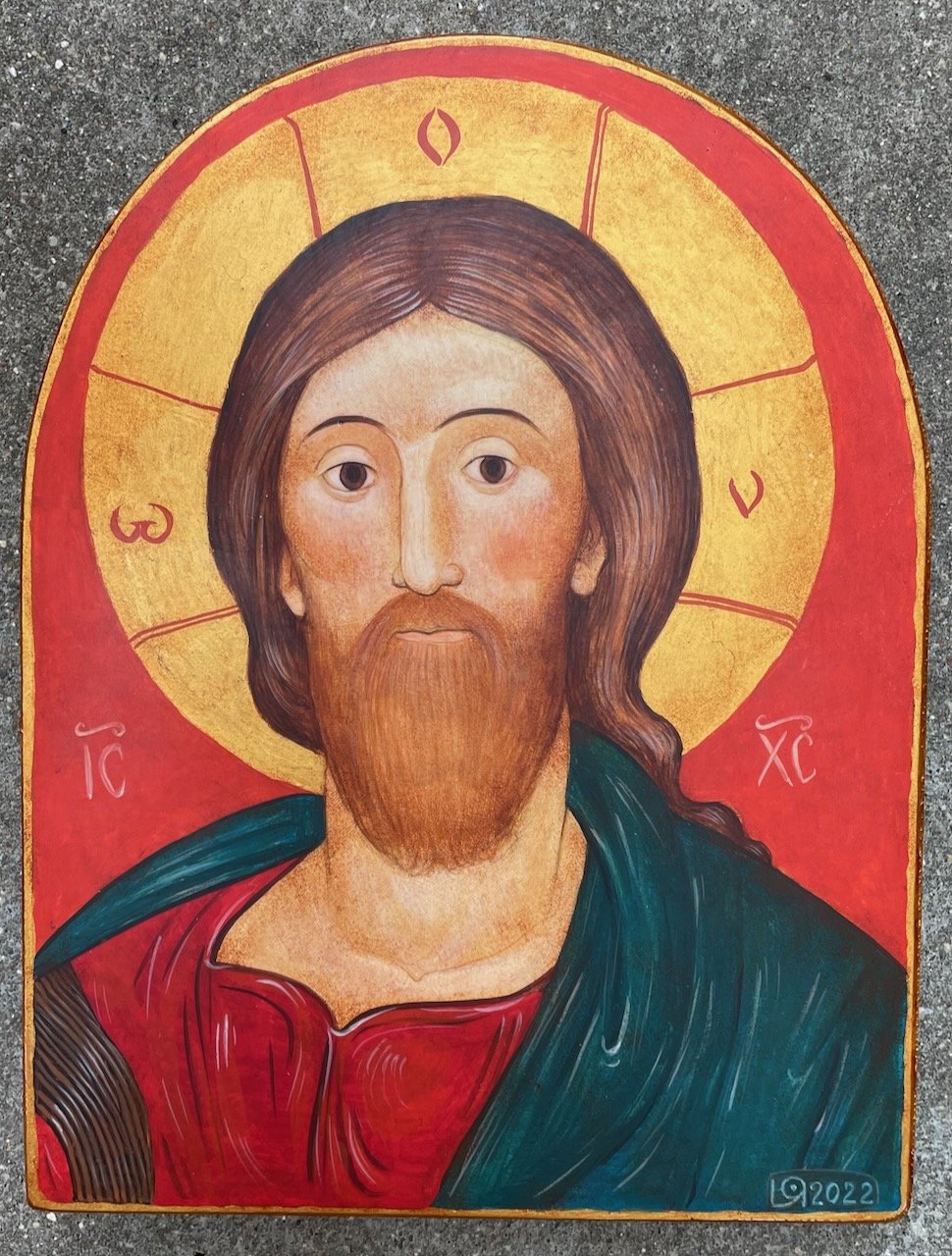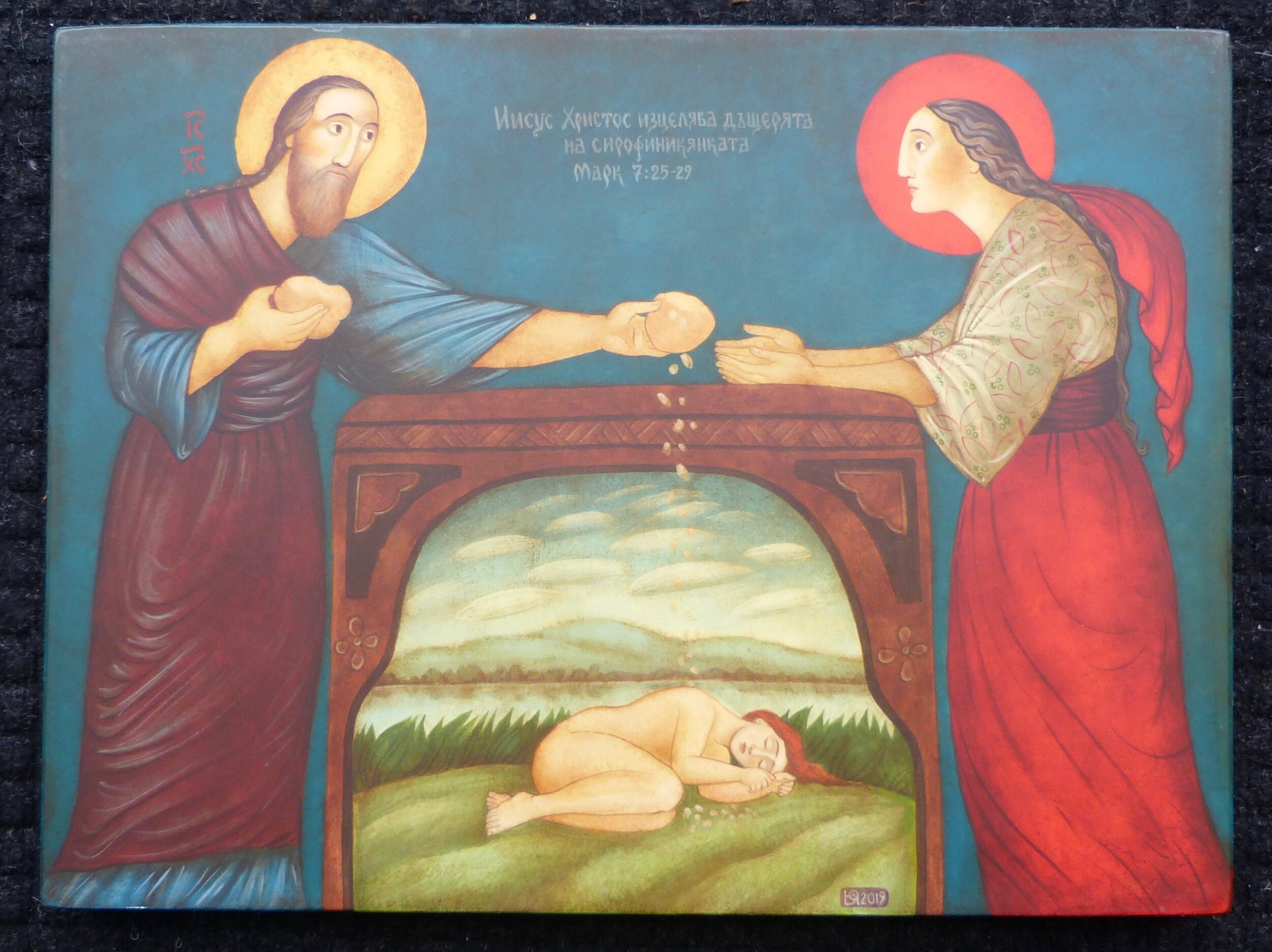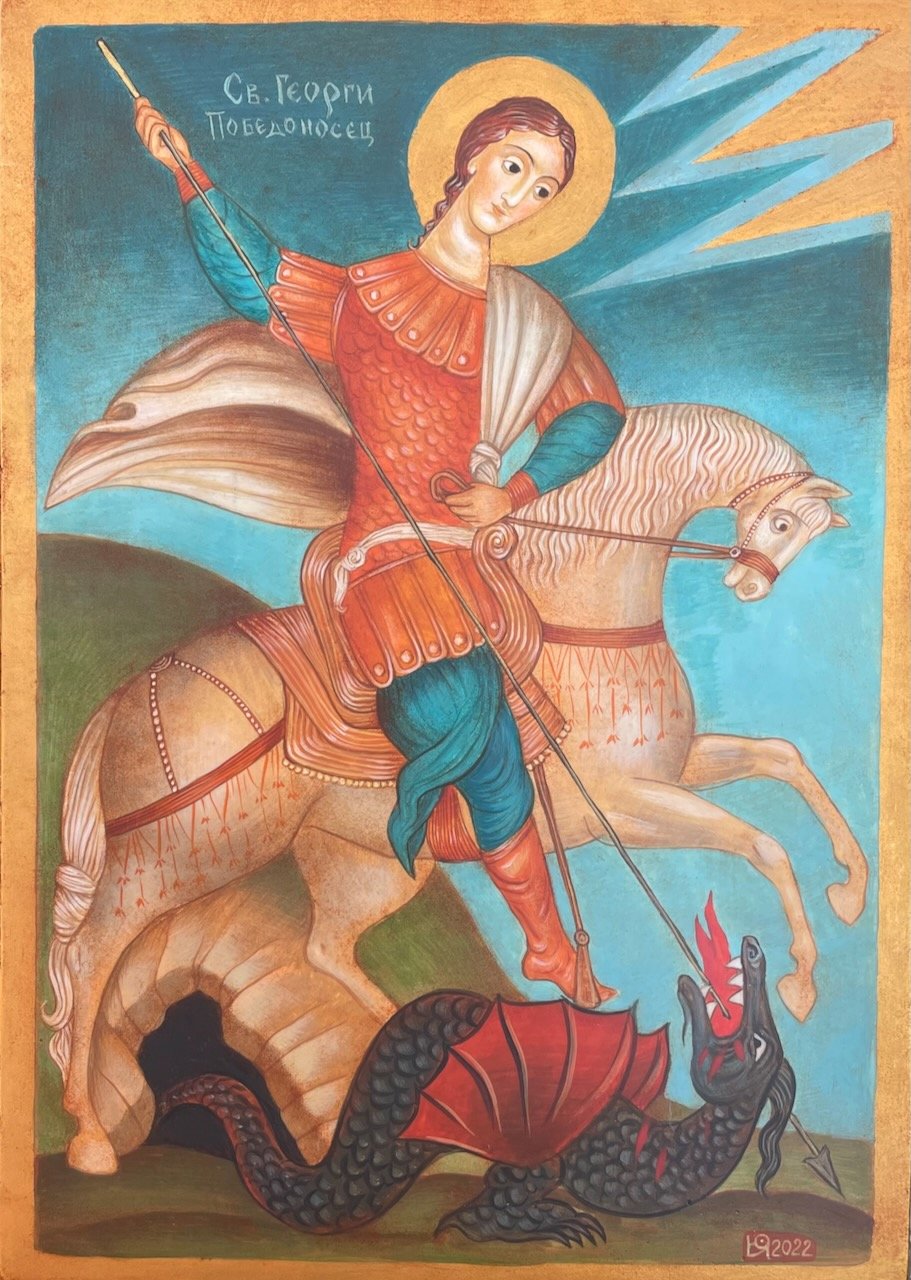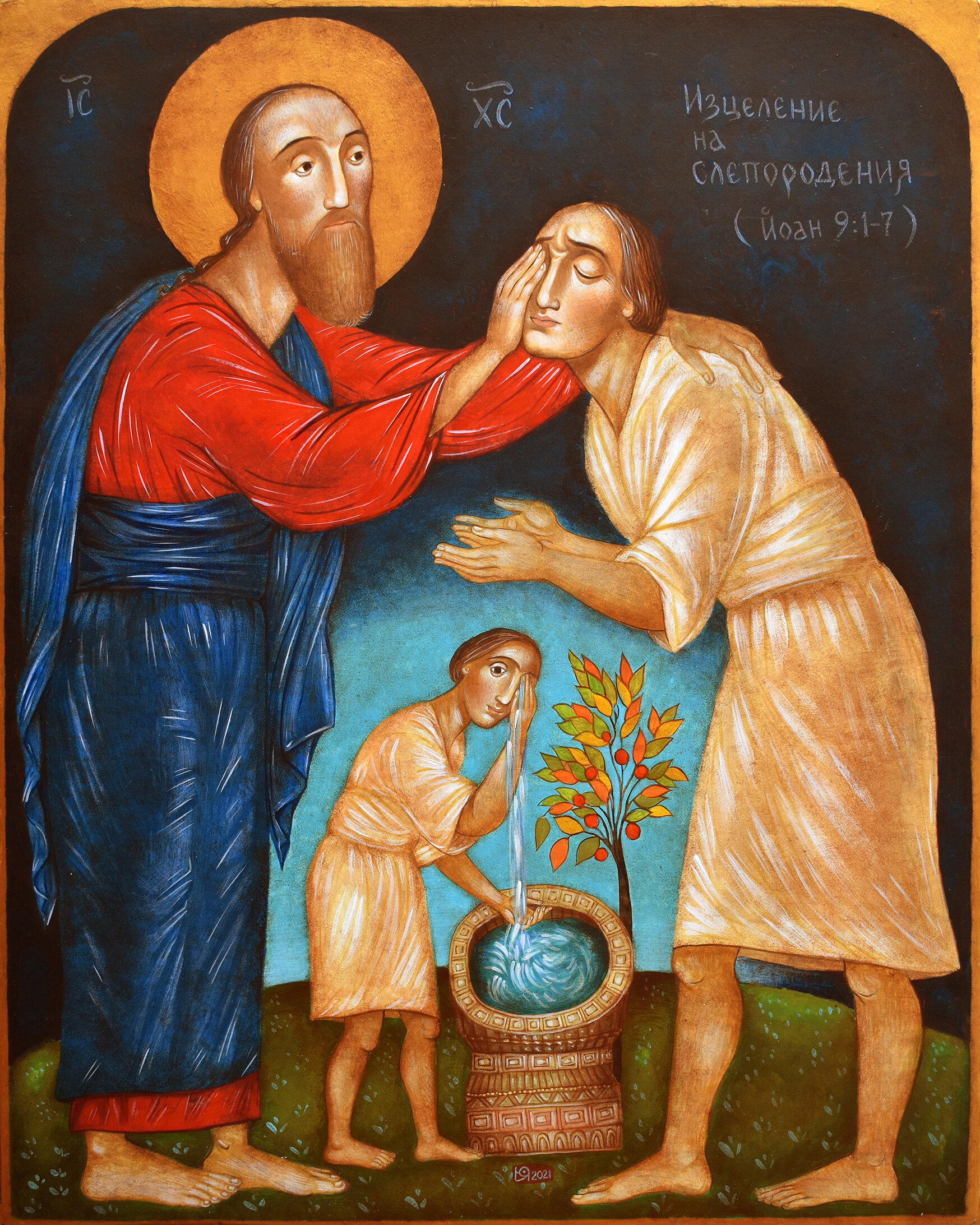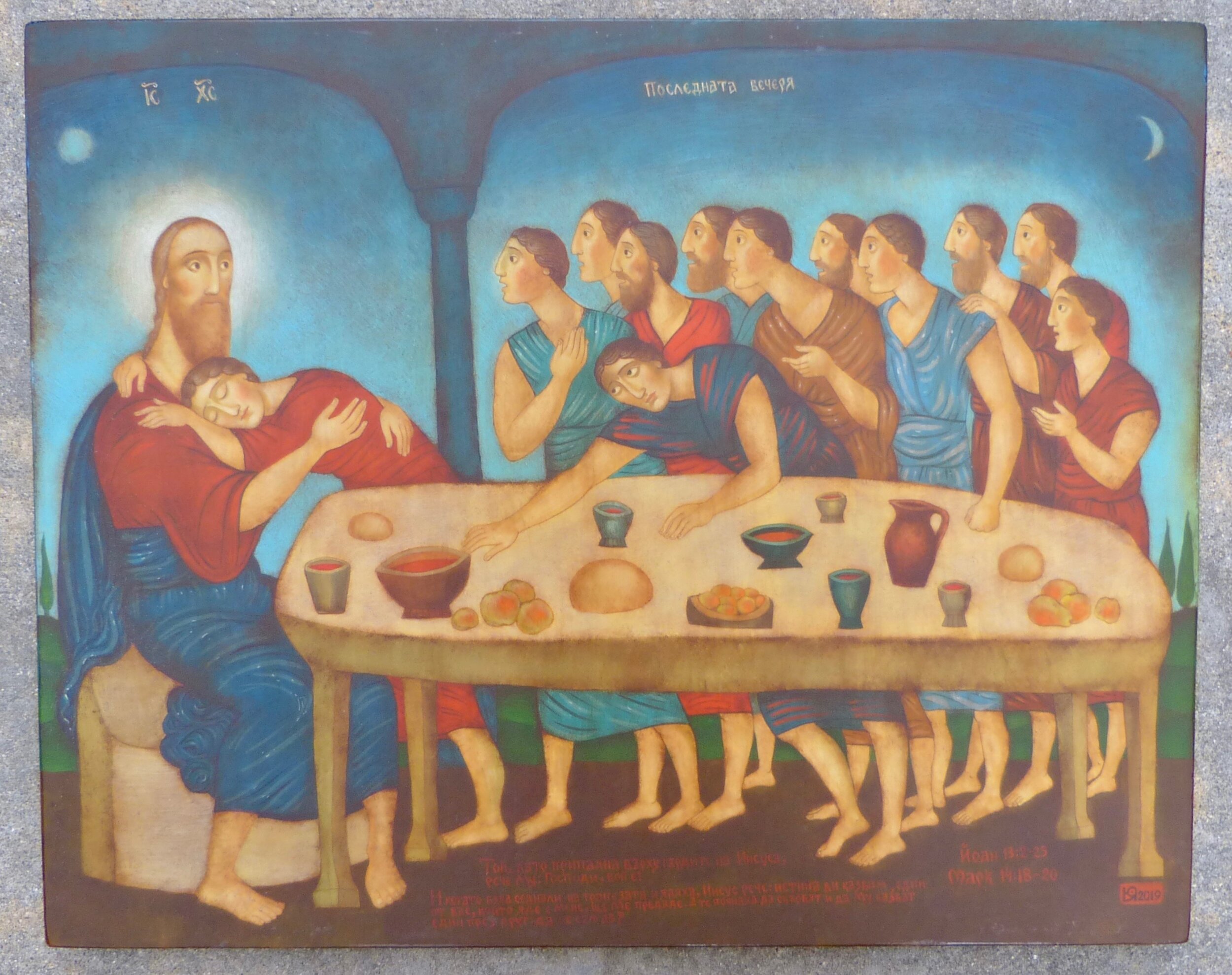The Washing of the Disciples’ Feet
By Iconographer and Fine Artist Julia Stankova
28” x 12”
Inquire about Price
The Transfiguration
By Iconographer and Fine Artist Julia Stankova
(Jesus is in the center, flanked by Elijah and Moses, with the Apostles Peter, James and John below)
15 1/2” x 19 3/4”
Sold
Julia Stankova
Our good friend Julia Stankova's works nearly bring us to tears each time we visit her in her apartment in Sofia, Bulgaria. Their aesthetic beauty captures our hearts in a way no other artistic creations do, moving our spirits to revel in their beauty.
Julia was born in 1954 in Haskovo, Bulgaria, and raised in Sofia. At the age of 13, she began taking private lessons in drawing and painting in order to apply to the National Academy of Fine Arts six years later.
Due to the political situation in Bulgaria at the time, she was not given a chance to follow this path, and had to become a mining engineer instead (MA, Mining and Geology University, Sofia, 1978), practicing in this capacity for 12 years. Despite this, she never abandoned her idea of becoming an artist and when the democratic changes happened (1989), she could at last return to her real interest.
Her first step in this direction was to start working in a private restoration studio run by friends. There she had the opportunity to closely observe and touch Bulgarian icons from the 18th and 19th centuries. The purity of feeling radiating from these icons inspired her to start studying the biblical texts and the philosophical principles of the Byzantine pictorial system. Her interest in this subject led her to study theology (MA, Sofia University, 2000).
Later, when she left the restoration studio, she was already mastering the technique of icon-painting on wooden surfaces. She started to develop a kind of symbolic art supported by her knowledge of the Byzantine pictorial heritage, on the one hand, and her emotional attraction to the biblical texts, on the other.
Art scholar Ivan Dodovski said of her works: "I am convinced that the icons of Julia Stankova will inspire real debates, because -- as every great art -- they are apparent and fundamental provocation. They are not works-copies, made in the shadow of the museum-determined Byzantine icon painting; entirely following its canonical-dogmatic principles. These works are the witness of the freedom of creation. They are also proof, peculiar remembrance, that the artistic language of Byzantium is not a metaphor or lamenting for the lost, but a trans-historical perspective."
Saint Francis of Assisi
By Iconographer and Fine Artist Julia Stankova
9 3/4” x 20”
Inquire about Price
Guardian of the World
By Iconographer and Fine Artist Julia Stankova
8” x 10”
Sold
Madonna and Child
By Iconographer and Fine Artist Julia Stankova
5 3/4” x 8”
Inquire about Price
Parting
By Iconographer and Fine Artist Julia Stankova
Sofia, Bulgaria
12" x 6"
Sold
Theotokos (Mother of God) II
By Iconographer and Fine Artist Julia Stankova
6” x 8”
Sold
The Last Supper
By Iconographer and Fine Artist Julia Stankova
Sofia, Bulgaria
15 1/2” x 19 3/4”
Sold
Christos Pantocrator
By Iconographer and Fine Artist Julia Stankova
6” x 8”
Sold
Noah’s Ark
By Iconographer and Fine Artist Julia Stankova
12” x 16”
Sold
Heavenly Wanderer
By Iconographer and Fine Artist Julia Stankova
7” x 9”
Sold
Found Sheep II
By Iconographer and Fine Artist Julia Stankova
12” x 16”
Sold
The Entry into Jerusalem
By Iconographer and Fine Artist Julia Stankova
Sofia, Bulgaria
14" x 10"
Sold
The Annunciation
By Iconographer and Fine Artist Julia Stankova
Sofia, Bulgaria
8" x 10"
Sold
The Resurrection of Lazarus
By Iconographer and Fine Artist Julia Stankova
13” x 19”
Sold
The Healing of the Blind Man of Bethsaida
By Iconographer and Fine Artist Julia Stankova
12” x 16”
Sold
Jesus Pantocrator
By Iconographer and Fine Artist Julia Stankova
Sofia, Bulgaria
7 1/2" x 11"
Sold
Madonna and Child
By Iconographer and Fine Artist Julia Stankova
Sofia, Bulgaria
6" x 8"
Sold
The Faith of a Syrophoenician Woman
By Iconographer and Fine Artist Julia Stankova
16” x 12”
Sold
Found Sheep I
By Iconographer and Fine Artist Julia Stankova
16” x 20”
Sold
The Anointing of Christ
By Iconographer and Fine Artist Julia Stankova
16” x 20”
Sold
The Last Supper
By Iconographer and Fine Artist Julia Stankova
19 1/2” x 12”
Inquire about Price
St. George and the Dragon
By Iconographer and Fine Artist Julia Stankova
7 1/2” x 10 1/2”
Inquire about Price
The Boat Church
By Iconographer and Fine Artist Julia Stankova
19 3/4” x 15 1/2”
Inquire about Price
Body, Spirit and Soul
By Iconographer and Fine Artist Julia Stankova
19 3/4” x 15 1/2”
Inquire about Price
Creation of Adam
By Iconographer and Fine Artist Julia Stankova
10” x 14”
Inquire about Price
The Guests of Abraham and Sarah
By Iconographer and Fine Artist Julia Stankova
19 1/2” x 14”
Inquire about Price
Acts of Eliaz
By Iconographer and Fine Artist Julia Stankova
Based on I Kings 19:4-5. Eliaz (Elijah) has been faithfully responding to God’s calling, but continues to be humiliated by others, so he rests under a broom tree, depressed, and an angel of God comes to comfort him.
19 1/2” x 11 3/4”
Inquire about Price
The Old Testament Trinity
By Iconographer and Fine Artist Julia Stankova
Sofia, Bulgaria
16" x 11 1/2"
Inquire about Price
Annunciation
By Iconographer and Fine Artist Julia Stankova
Vintage (1990)
10” x 13”
Inquire about Price
Theotokos (Mother of God) I
By Iconographer and Fine Artist Julia Stankova
8” x 12”
Sold
The Healing of the Blind-Born Man
By Iconographer and Fine Artist Julia Stankova
15 1/2” x 19 3/4”
Sold
Found Sheep III
By Iconographer and Fine Artist Julia Stankova
Sofia, Bulgaria
12” x 16”
Sold
Noah’s Ark
By Iconographer and Fine Artist Julia Stankova
Sofia, Bulgaria
12” x 19 3/4”
Sold
Christ and the Samaritan Woman
By Iconographer and Fine Artist Julia Stankova
16” x 12”
Sold
Jonah
By Iconographer and Fine Artist Julia Stankova
Sofia, Bulgaria
11 1/2” x 16”
Sold
The Conception of Anna
By Iconographer and Fine Artist Julia Stankova
12” x 16”
Sold
Healing of a Demon-Possessed Man
By Iconographer and Fine Artist Julia Stankova
12” x 16”
Sold
Last Supper
By Iconographer and Fine Artist Julia Stankova
19 1/2” x 15 1/2”
Sold

